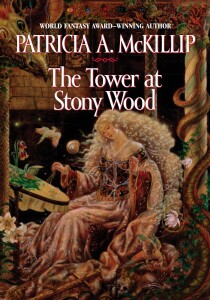 Patricia A. McKillip seems to write two kinds of novels. On the one hand, she has produced what I can only call thoughtful adventure stories, such as Riddle-Master. On the other are what I call the “mystery” stories — not detective fiction, but those stories that involve a central mystery in the religious sense: a transcendent image that cannot be explained or really even described. The Tower at Stony Wood is one of the latter.
Patricia A. McKillip seems to write two kinds of novels. On the one hand, she has produced what I can only call thoughtful adventure stories, such as Riddle-Master. On the other are what I call the “mystery” stories — not detective fiction, but those stories that involve a central mystery in the religious sense: a transcendent image that cannot be explained or really even described. The Tower at Stony Wood is one of the latter.
Regis Aurum, King of Yves, is marrying Gwynne, the Lady of Skye, a subject realm. Cyan Dag, landless but in the king’s favor, senses something wrong. His sense is confirmed by the Lady’s Bard, but Cyan is reticent. He has no evidence that this creature is an imposter, only suspicion, and he hopes to marry Cria Greenwood, whose father has no time for landless knights, so he’s not anxious to lose Regis’ goodwill. Then the Lady herself sends him on a mission, although he thinks he is going in spite of her.
Cyan travels to Skye to free the real Gwynne from the tower in which, he is told, she has been imprisoned. On the way he meets Melanthos, who like Gwynne spends her days in a tower making pictures of thread; Sel, Melanthos’ mother, who is drawn into the same pastime until she remembers who she is; Thayne Ysse, who seeks to free a dragon and so have revenge against Yves and its king; and the Bard’s sisters, whose answers are all questions.
The metaphor is needlework. McKillip used it in Solstice Wood as a means of maintaining the boundary between reality and the Otherworld. In Stony Wood, it is the device that provides passage through time and space, into and out of dreams. Gwynne in her tower embroiders the world as seen through a mirror. Melanthos embroiders Gwynne’s life, also seen through a mirror. Sel looks in the same mirror and sees the scenes from her own life that lead her back to her magic and herself. Cyan Dag is guided on his journey by the scraps of Melanthos’ embroidery carried on the winds.
The text is McKillip’s characteristic melding of contrasts: not only reality and whatever lives beside it, but direct, plain language that speaks most eloquently through things left unsaid, and sharp dialogue that moves imperceptibly into poetry. There are passages describing Cyan Dag’s transitions through realities that strongly echo Morgon’s transitions in Riddle-Master, sequences that are as much like fever dreams as anything in Winter Rose, and scenes with the kind of topsy-turvy logic that I first remember from The Forgotten Beasts of Eld.
This is not to say that this is the archetypal McKillip novel. Rather, McKillip displays an unusually strong and consistent voice and has staked out a territory that I don’t think anyone else has explored. She has entered the realm of “literary” fantasy from her own direction, using her own means, and inhabits that place quite comfortably, without the evident “artistry” that so often seems self-conscious.
And after all this, I am honor-bound to point out that the resolution of the various strands is weak and there is a huge hole. McKillip’s stories tend to have happy, albeit sometimes bittersweet endings, but here, given the passion of Thayne Ysse, the continual deceptions of the Three Sisters, and the violence inherent in characters such as Thayne and Cyan (not to mention the dragon) one feels the stretch in coming up with a bloodless finish — and it is pretty bloodless, to the extent that it doesn’t quite ring true.
And there is Cria, who is a participant in two tender scenes and pretty much a nonentity for the rest of the book. If this is a love match, I shudder to think how barren an arranged marriage would be. True, Cyan does think of her once or twice on his journeys, but it seems pretty much pro forma. Perhaps it’s just a function of Cyan’s character, which I can legitimately call underdeveloped. He’s largely a pawn, and not fully realized. McKillip’s narrative is strong, and we don’t really notice while immersed in the story, but in retrospect, Cyan is more a plot device than a person, which from McKillip is a surprising lapse.
I’m coming to think of McKillip more and more as a writer of young adult fiction. I come to this conclusion, mind you, having first read The Forgotten Beasts of Eld and Riddle-Master, which are both considered young adult but nevertheless to my mind are subtle and powerful stories. The Tower at Stony Wood is a “good book” by that standard, but it misses the depth of McKillip’s best work. Oh, well. Nobody bats a thousand.
(Ace Books, 2000)
